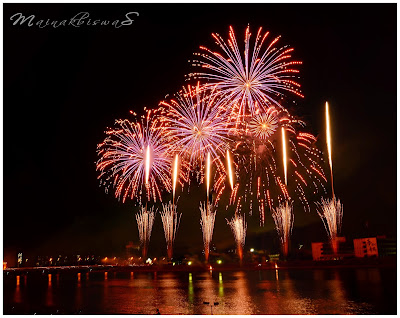Shooting Fireworks!!
Fireworks
Fireworks are probably one of those few things that people
enjoy irrespective of their age and interests! Staying in Japan, a country that
literally “celebrates” fireworks,
I learnt a lot of tips-and-tricks about the art of photographing Fireworks. Most
of my learning has been through this one mantra – “SHOOT – REVIEW – ADJUST –REPEAT” !!
Epilogue:
In India, we
have an entire festival dedicated to illumination and fireworks, DIWALI -- the
festival of lights.. But while I was in India, neither did I own a DSLR, nor
was I much interested in clicking fireworks, as, like most other kids, I was
more inclined towards bursting crackers rather than capturing them.
Although Japan
doesn't have a festival dedicated to fireworks, nor is the-common-man is
allowed to burst fire-crackers. But, on the contrary, around the end of summer,
there are big firework shows (花火大会) in almost every important city of this country.
During my 4 year stay,
I had visited many of them (in different cities). Although I had heard that
Osaka's firework-show is one of the best in Japan, personally, I found the one
in Oita (a small city in the Kyushu island) to be much better.
Fireworks photography: Camera Settings, Tips and Tripod
When it was the first time that I was
going to shoot a complete fireworks show, I had done some a lot of background
reading from the internet. I concluded that the location, timing and Tripod is
of utmost importance. I mounted my camera on a sturdy tripod and positioned it
so that the two-thirds of the frame was the sky, and the remaining one-third
was the water, so as to try and capture the reflection.
Here are some of links that might be helpful:
1. Tips for Fireworks Photography
2. How to Photograph Fireworks
3. Fireworks Photography Camera Settings
Personal Experience:
Here are some important aspects I learnt
about Capturing fireworks:
Ideally we want a long exposure anywhere between 1-30 seconds for a silky water effect. But, in events like these, there are too many fireworks fired in a relatively small interval of time, making some shots too bright as well as making the bursts in-decipherable from each other. I realized this in the first 10-15mins, and henceforth the max exposure I used was 5secs.
It’s better to disengage the auto-focus on your lens (manually set it to Infinity) and shoot in complete manual mode (at times using the "bulb mode" for random exposure). The problem with autofocus in these cases is that the camera will try to refocus after every single burst, thereby losing the "crisp-ness" of the snap.
And, now comes the "special three".
Ideally we want a long exposure anywhere between 1-30 seconds for a silky water effect. But, in events like these, there are too many fireworks fired in a relatively small interval of time, making some shots too bright as well as making the bursts in-decipherable from each other. I realized this in the first 10-15mins, and henceforth the max exposure I used was 5secs.
It’s better to disengage the auto-focus on your lens (manually set it to Infinity) and shoot in complete manual mode (at times using the "bulb mode" for random exposure). The problem with autofocus in these cases is that the camera will try to refocus after every single burst, thereby losing the "crisp-ness" of the snap.
And, now comes the "special three".
Strategy used to
capture these: after the first burst, cover the lens with the black lens cap;
move the camera a little bit, remove the cover just at the time of the next
burst and so on. In this way, I was able to capture 3-4 bursts on the same pic
without them overlapping on each-other!! :)
Equipment used:
Nikon D7000
Nikkor 18-200mm lens
Camera Settings:
ISO: 100
Aperture: f/11, f/14, f/16




